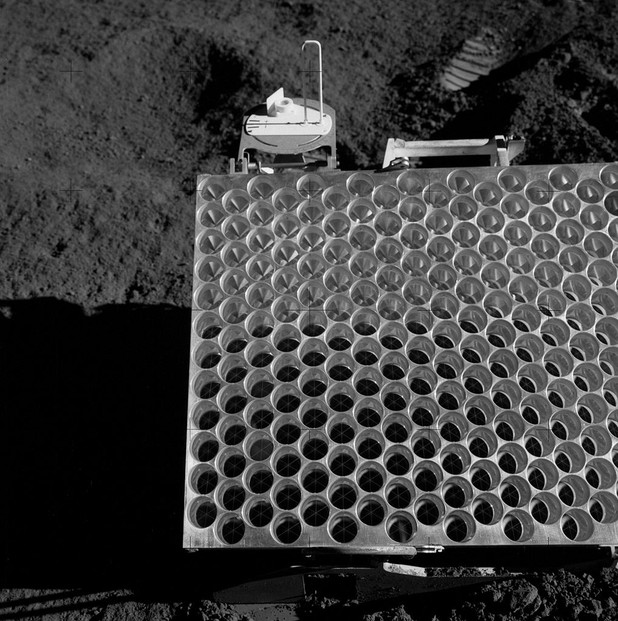Lunar Laser Ranging RetroReflector (LRRR) array placed and photographed on Moon July 31, 1971, by Commander David "Dave" Randolph Scott (born June 6, 1932) during Apollo 15 mission
NASA's ongoing Lunar Laser Ranging experiments measure distances between Earth and Moon via retroreflectors placed on Moon during Apollo program (missions 11, 14,15).
Apollo 15 LRRR array is sited on Palus Putredinis, eastern edge of Mare Imbrium, in near side's Hadley-Apennine region.: Generally not subject to copyright in the United States, via NASA @ https://www.nasa.gov/mission_pages/LRO/multimedia/lroimages/lroc-20100413-apollo15-LRRR.html
Observing the moon: lower of two green beams is from Lunar Reconnaissance Orbiter's dedicated tracker; other laser originates from ground system at NASA Goddard Space Flight Center. Both beams are pointed at LRO orbiting Moon.
Lunar Ranging Facility, Geophysical and Astronomical Observatory, NASA Goddard Space Flight Center, Greenbelt, Maryland: NASA, Public Domain, via Wikimedia Commons @ https://commons.wikimedia.org/wiki/File:Goddard_Spaceflight_Center_Laser_Ranging_Facility.jpg; "Observe the Moon," NASA image article Sep. 28, 2010, Generally not subject to copyright in the United States, via NASA @ https://www.nasa.gov/image-article/observe-moon/
Giant Impact Hypothesis, also known as Big Splash or The Theia Impact: Moon formed from debris from Mars-sized protoplanet -- named Theia for Greek Titan mother of moon goddess Selene by Alexander Halliday in 2000 -- obliquely grazing Earth 4.5 bya.
"Planetary Smash-Up," artist's concept of Moon-sized celestial body speedily slamming into Mercury-sized body; similar high-speed collision detected by NASA's Spitzer Space Telescope near young star HD 172555, sited about 100 light-years from Earth.
"PIA12166: Planetary Demolition Derby (Artist Concept)," image addition date 2009-08-10; image credit NASA/JPL-Caltech:May be used for any purpose without prior permission, via NASA JPL Photojournal @ https://photojournal.jpl.nasa.gov/catalog/PIA12166; Generally not subject to copyright in the United States, via NASA @ https://www.nasa.gov/multimedia/imagegallery/image_feature_1454.html
First image of the far side of the Moon was obtained by Soviet spacecraft Luna 3, or E-2A No.1, at 03:30 UT on October 7, 1959, at distance of 63,500 kilometers.
first of 29 photographs taken, covering 70 percent of far side: North is up; dark spot (upper right) = Mare Moscoviense; dark area (lower left) = Mare Smythii
NASA Image ID number Luna3_1; NASA Space Science Data Coordinated (NSSDC) Image Collection, Goddard Space Flight Center (GSFC): Public Domain, via NASA GSFC NSSDC @ https://nssdc.gsfc.nasa.gov/imgcat/html/object_page/lu3_1.html
Far Unseen Side of Moon: Lunar Reconnaissance Orbiter Camera (LROC) Wide Angle Camera (WAC) mosaic of Lunar South Pole encompasses Aitkin Basin, one of Solar System's largest known impact craters.
"PIA13523: The Lunar South Pole," image addition date 2010-09-27; image credit NASA/GSFC/Arizona State University: May be used for any purpose without prior permission, via NASA JPL Photojournal @ https://photojournal.jpl.nasa.gov/catalog/PIA13523; NASA/GSFC/Arizona State University: Public Domain, via Wikimedia Commons @ https://commons.wikimedia.org/wiki/File:LRO_WAC_South_Pole_Mosaic.jpg















 Are Hawaiian Huakai Po Nightmarchers Avenging Halloween Thursday?on 10/02/2024
Are Hawaiian Huakai Po Nightmarchers Avenging Halloween Thursday?on 10/02/2024
 Mailing Addresses for 2023 Form 4868 Extending 1040 and 1040SR April 15, 2024, Due Dateon 04/15/2024
Mailing Addresses for 2023 Form 4868 Extending 1040 and 1040SR April 15, 2024, Due Dateon 04/15/2024
 Mailing Addresses for 2023 Forms 1040 and 1040SR Filed in 2024on 04/15/2024
Mailing Addresses for 2023 Forms 1040 and 1040SR Filed in 2024on 04/15/2024
 Mailing Addresses for 2022 Form 4868 Extending 1040 and 1040SR April 18, 2023, Due Dateon 04/13/2023
Mailing Addresses for 2022 Form 4868 Extending 1040 and 1040SR April 18, 2023, Due Dateon 04/13/2023



Comments
Another follow-up book could consider conveying how space configures from our Moon.
Could it not challenge Moon crowds less to consider configurations such as constellations without Blue-Marble pollution and space debris?
Werner von Braun not only advanced space science but also space-science fiction.
Might not a filmed First men on the moon make for happy passengers on Earth-Moon, Moon-Earth flights
How We'll Live on Mars considers passenger fares to and from the red planet by 250-day flights each way as covering costs and creating profits.
Passenger fares could cover Earth-moon flight costs and create profits.
Online sources describe Earth-moon flights as three days.
What might make for happy passengers on such lunar flights?
The computer crashed afore I carved another component into my comment below.
Wouldn't it be wondrously wonderful for authors Chu, Paech and Waegand to wend their way through the most updated works on potentially colonizable Mars and potentially colonizable Moon?
This book has such clear, useful images and information!
Wouldn't it be wondrously wonderful for authors Chu, Paech and Waegand to wend their ways through a follow-up work?
happynutritionist, Watching that first moon landing via TV is one of those happy historic events which definitely warrants a great big plus mark in the lives of lucky viewers.
But me, too, I agree that the others need to be remembered as well.
Excellent photos, with the passage of years, we forget some of the moon landings, we never forget the first, I remember where I was when watching it on TV, but the others become a blur and shouldn't be.